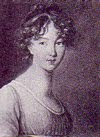Thanks to the comments on the first post (http://historyknits.blogspot.com/2012/08/19th-century-knitting-from-painting.html) about this project, I finished this as a double stocking cap, one that is folded inside of itself. The first half, when I was not sure exactly what I was knitting, measured 29 ½” long, with a width of 16” around. I doubled the length, knitting the second part in the natural/undyed yarn as in the original painting.
The
cap was knit on 5.5mm/US 9 sized needles using Brown Sheep Nature Spun Worsted
in Winter Blue, Natural, Red
Fox, Charcoal, and Lullaby. I put it through two laundry cycles with bed
sheets in the washing machine on hot water, and dried it by air over a rack.
The cap fulled in terms of width but not all that much in length, losing only
9” (down to 20 ½”) and only 4 ½”
(down to 11 ½”) around.
I based my
original measurements on a comparison with the body of the young girl knitting
in the painting, using a child of a similar age as a model. Shrinking the cap
down by hand might have produced a cap that would fit a child but I think I
really needed to have twice the width, and have worked on larger
needles. As it is, my cap would fit a baby’s head but then I am not going to
re-knit the whole cap to make it about twice its size to allow for fulling. It
was just fun to reproduce knitting from a painting.
{Apologies for the two sizes of font. I cannot seem to correct it.}
{Apologies for the two sizes of font. I cannot seem to correct it.}





